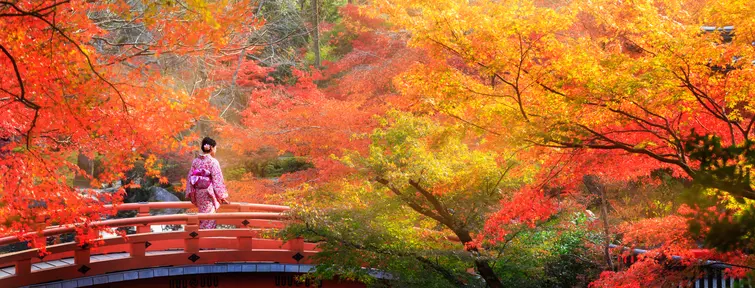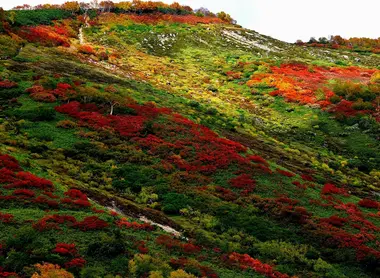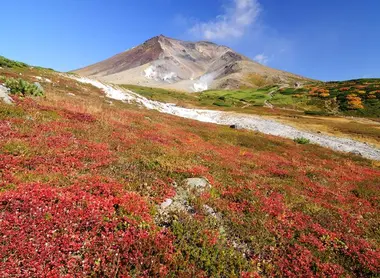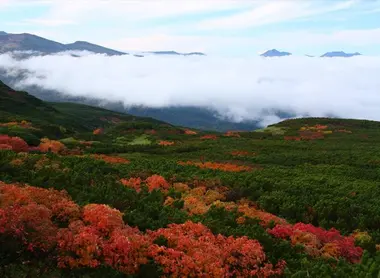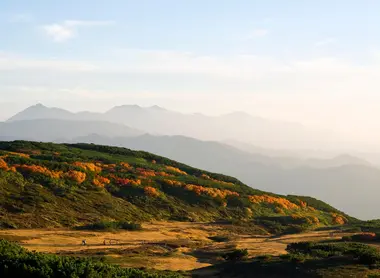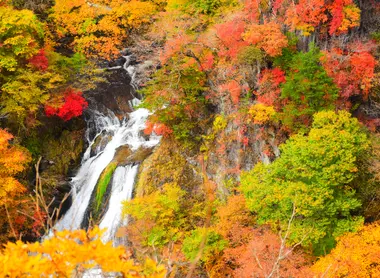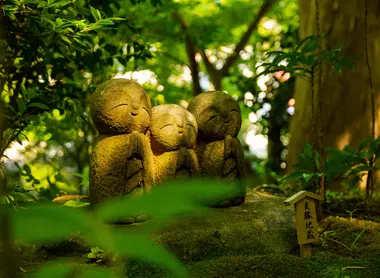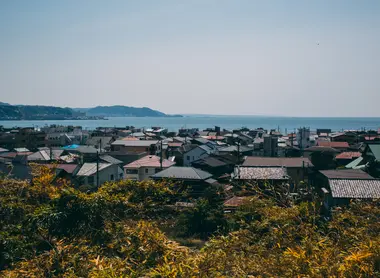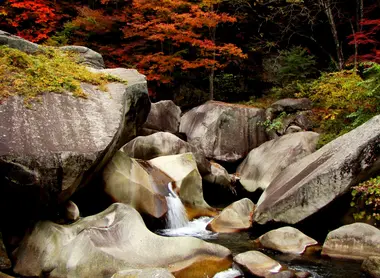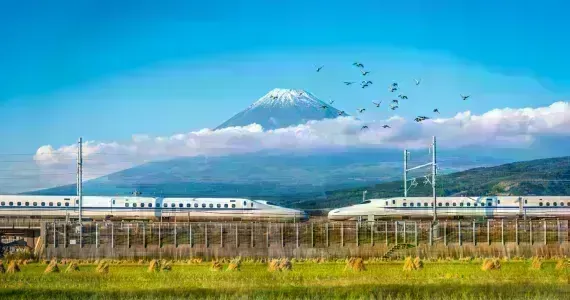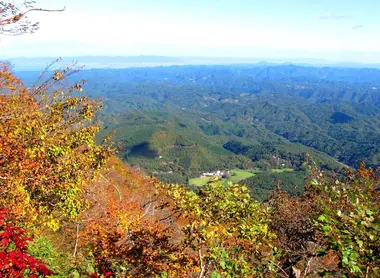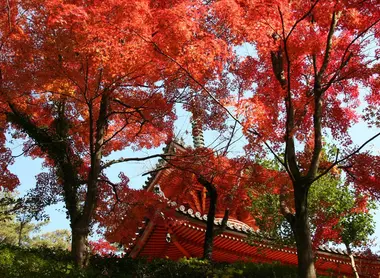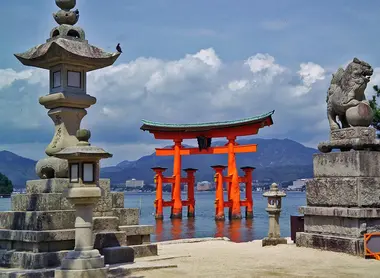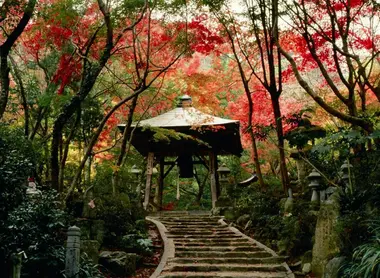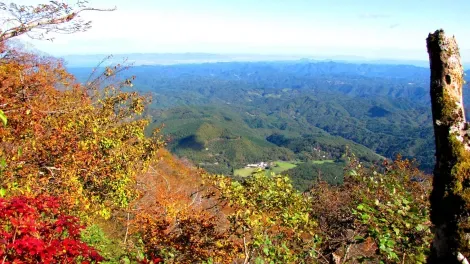Autumn Leaves Viewing Places 紅葉スポット
This fall, Japan Experience shares its selection of the best places to enjoy the Japanese phenomenon of kōyō, when the natural landscape is transformed and the leaves turn red. From North to South, discover places to see autumn leaves in every region of Japan.
Fall Leaves in Japan 紅葉
Japanese art and culture has a deep and enduring relationship with the changing of the seasons. Just as the blooming of cherry blossoms is celebrated during hanami season (cherry blossom viewing) in March and April, so are the autumn colors enjoyed in the fall, usually in mid to late November, before the onset of winter and the coming of the plum blossoms in February. Travel all around the country and see the amazing fall foliage using a Japan Rail Pass!
Admire the colors of autumn
The changing of the colors of the leaves in Japan is known as kōyō (紅葉) or momiji when referring to maples and has become a major part of the tourist industry as people in tour buses and cars flock to the most famous temples and shrines for fall colors in Kyoto and Tokyo as well as the most beautiful mountains and gorges across the country, where the colorful autumn spectacle can best be enjoyed.
The cherry blossoms bloom first in Okinawa and gradually open across Kyushu, Shikoku, Honshu and finally Hokkaido. The kōyō season is the reverse, beginning in Hokkaido and traveling down through Honshu to Kyushu. Though trees at altitude will have their leaves change color before those at sea level.
The main colors are the brilliant reds and scarlets of the Japanese maple as well as the pale yellow of the ginkgo tree.
Japan has two type of foliage : the red momiji and the yellow momiji. The Japan Meteorological Corporation has now released the 2023 foliage forecast.
According to these forecasts, northern Japan will be the first to see autumn leaves, from late October 2023, with peak foliage in early November 2023.
On the main island of Honshû, autumn leaves will appear from mid- to late-November. In other regions, such as Osaka and Kyoto, the kôyô season will begin towards the end of November, with a peak in early December.
Forecasts show that the best days to see the red momoji are around November 14 in Aomori, November 30 in Tokyo, between December 3 and 11 in Kyoto and Osaka, and December 9 in Fukuoka.
Where to see the fall foliage : Our Travel Guide by region
Hokkaido
The northern island of Hokkaido has Japan's earliest kōyō and some of the countries most dramatic scenery.
- Onuma Park
About twenty kilometers north of Hakodate lies Onuma Park. Covering an area of 90 km², it is the ideal place to go on an "autumn leaf hunt" (momiji gari). Every year, the vegetation begins its transformation in mid-October. We advise you to visit the park during the second half of October to admire its magnificent maples, beeches and red oaks. Don't miss the lake view from Shuho Komagatake (1,131 meters); it's breathtaking!
- Daisetsuzan National Park
It's in the heart of Hokkaido that the kōyō season, autumn colored foliage, begins. From the beginning of September, the leaves start to change color and all of Daisetsuzan National Park, with a total area of 220,000 hectares, is colored yellow, red and orange, to the delight of visiting nature lovers.
Daisetsuzan National Park is a real treasure in the heart of Hokkaido, to be discovered over several days if you have time. Each period has its interest. Be aware that the hiking trails are not very difficult but they can be long and tiring. In addition, in winter, it is better to take precautions and check that all the trails are passable. Also beware of the brown bear, which drags its few hundred kilos through the forests, in search of food. The sound of a bell hanging from your bag will keep it at bay.
- Shiretoko Peninsula
At the eastern end of the island of Hokkaido lies one of the most beautiful sites in Japan, Shiretoko, a fantastic natural and protected conservatory. Shiretoko is the mountainous peninsula that stretches towards the Kuril Islands, at the extreme northeast of Hokkaido. The Shiretoko National Park in North-East Hokkaido is one of the best, and earliest places to see the autumn colors in Japan, usually beginning in mid-October.
Tohoku
The prefectures of Akita and Aomori are both well-known for the quality of their autumn leaves viewing places.
- Oirase Gorge and Lake Towada
The picturesque Oirase Gorge is one of the best places to see the fall colors in Japan, either by car or tour bus or by following the river along a hiking trail. The Oirase Gorge is a popular destination for cyclists and hikers. For 14 kilometers between Yakeyama and Nenokuchi, on the shore of Lake Towada and at the foot of Hakkoda-san, lies the fantastically beautiful Oirase Gorge. The crystal clear Oirase River flows along the road through a beautiful forest, known for its spectacular autumn foliage colors.
- Hirosaki Castle
Hirosaki Castle in Hirosaki in Aomori Prefecture is known for both its cherry blossoms and spectacular autumn leaves. To the west of Aomori is the charming city of Hirosaki. In addition to its monumental castle park, famous for its thousands of cherry trees, the town has several Edo period wooden houses formerly owned by local samurai and merchant families, a collection of Meiji era (1868-1912) buildings, the Fujita Memorial Garden, a botanical garden in the castle park, and beautiful temples, including the five-story Saisho-in pagoda.
- The Gorges of Naruko (Narukokyo)
Parallel to National Highway 47, the V-shaped valley was formed by the erosion of the Oya River.
The cliff, about 100 meters high, continues for 2.5 kilometers between pines and rocks. In the autumn, buses run between Naruko onsen and Nakayamapei onsen stations. In the Naruko Valley, trees turn orange in mid-October. The best time to visit the gorge is from mid-October to the beginning of November. You can admire vine leaves (acer rufinerve) and flowering shrubs called koshiabura (chengiopanax sciadophylloides). Narukokyo Resthouse has an observation deck with a magnificent view of the Ofukazawa Bridge and Naruko Gorge.
Kanto
Kanto, the area of northern Japan surrounding and including Tokyo has many places to enjoy the fall colors, many of which make for an interesting day trip from the capital or a longer stay.
- Chichibu-Tama-Kai National Park
The area around the Mitsumine Shrine in Saitama Prefecture has hiking paths from the Mitsumine all the way to Mount Kumotori and is beautiful in autumn. The area is all part of the impressive Chichibu-Tama-Kai National Park. The Park allows easy escape from the urban conglomeration of greater Tokyo. Its many hiking trails offer the escapee not only wilderness, but the facilities to make the most of that wilderness.
- Hakone
Hakone, west of Tokyo, is an easily-reached natural area from Tokyo and the leaves can be seen throughout the month of November. Hakone is not especially famous for fall colors but there is plenty of autumn splendor to admire.
- Kamakura
Kamakura, an easy day trip from Tokyo, offers refined autumn colors in its many historic Kamakura Period and Muromachi Period temples and shrines. Kamakura's coastal location means the season usually starts later than other areas.
- Nikko
The highland areas close to Nikko are justly famous for their autumn leaves including Lake Chuzenji and the Kegon Falls area and the Kirifuri Highland and Kawaji and Yumoto Onsens.
- Oze
Oze National Park is a popular hiking spot about 100 km north of Tokyo. This is Japan's largest area of highland marsh, and is renowned for its vistas of wild flowers and majestic mountain scenery. Oze is a spectacular example of what beauty nature can produce with fire and brimstone. Lava from an eruption of the nearby Mt. Hiuchigatake dammed the Tadamigawa River creating the marshlands, which Kita Tadamigawa is still the prime source of water for.
In autumn the marshland grasses turn a lovely red and yellow color. In early autumn the nikko-kisuge (yellow alpine lily) can also be seen.
- Shosenkyo Gorge
Shosenkyo is scenically sublime, and in national polls of Japan's favorite beauty spots is usually among the top five. The picturesque Arakawa River (a tributary of the Fuji River) flows from Mt. Kimpu (2,595 m) and Mt. Kokushi (2,592 m) before it enters the Kofu Basin. Shosenkyo Gorge, near the city of Kofu in Yamanashi Prefecture, can be enjoyed in the fall by walking along the paths following the scenic Arakawa River.
Book your Japan Rail Pass now
Tokyo
- Hama-Rikyu Garden
Hama-rikyu Garden is another Edo Period strolling garden which is beautiful year round but is especially popular in early spring for the cherry blossom and autumn for its maple leaves. It is a beautiful and historical tract of parkland near the Shiodome district, and beside the Sumida River, where that river enters Tokyo Bay.
- Icho Namiki (Ginkgo Avenue)
Icho Namiki is an avenue of gingko trees (the municipal flower of Tokyo) that are pruned to look almost like pines. The line of trees is in Meiji Jingu Gaien Park in Aoyama.
- Koishikawa Korakuen
Koishikawa Korakuen, near Tokyo Dome, is an Edo Period strolling garden that once belonged to the feudal lord of Mito and along with Rikugien (see below) one of Tokyo's best places to enjoy the shades of autumn. The garden is heavily influenced by Chinese garden design. The name - Korakuen - comes from a Chinese text and can translate as "garden for enjoying power later".
Mount Takao is a mountain rising to 599 meters above sea level and is located in the almost national park of the Meiji-Takao Forest; one of the smallest parks in the country, covering only 7.70 km². Although small in size, it includes 1,200 species of plants, a hundred species of wild birds and more than 5,000 species of insects! The best time to visit Mount Takao and admire its Japanese maples (Acer palmatum) and Japan varnishes (yama-urushi, toxicodendron vernicifluum ) is throughout the month of November.
- Rikugien Garden
Rikugien Garden is an Edo Period landscaped garden designed for strolling and has some of the capital's best fall colors. The gardens are open at night and illuminated during the peak season. The garden covered ten hectares (almost 25 acres).
Rikugien Garden's strolling paths give the visitor views of a variety of charming scenery, including a large pond with islands, and a hill covered with a dense grove of ancient trees.
- Yoyogi Park
Yoyogi Park has numerous Japanese maples and ginkgo trees, most notably in the south of the park. The park and the grounds of the adjacent Meiji Jingu Shrine form one of the largest and most easily accessible expanses of greenery in Tokyo.
While not as celebrated as the reds of Momiji (Japanese Maple), carpets of golden Ginkgo leaves are a common sight in the autumn at shrines and temples.
Chubu (central Japan)
The Chubu area of central Honshu includes the Japanese Alps in Nagano and Gifu prefectures and also parts of the Nakasendo Highway, nowadays a popular hiking route. These mountain areas are perfect places to enjoy the autumn canvas.
- Ena Gorge
The Ena Gorge near Ena, a former post town on the Nakasendo, can be enjoyed by cruise boat on 30-minute tours. In the Ena Valley in Gifu Prefecture, about an hour north of Nagoya, there is much to see and do. Historically important due to its position on the Nakasendo inland highway between Kyoto and Edo (Tokyo), visitors can now take a ride on the historic Akechi Railroad to the Taisho Village in Akechi, see the former castle town of Iwamura or take a hot soak in the quaint onsen in Hanashiro, a stone's throw from the tiny station.
- Hirugami Onsen and Tenryu River
Hirugami Onsen and Tenryukyo Gorge not far from Iida in Nagano are both known for their autumn tapestries of colors.
- Kiso Fukushima
Kiso-Fukushima was an important check-point on the Nakasendo and its historic sekisho, or barrier station, is one of only two on the route. Kiso-Fukushima is located about directly half-way on the Nakasendo from Edo (Tokyo) to Kyoto. The historic town of Kiso Fukushima is the ideal base for hiking into the surrounding mountains to view the autumn leaves. Karasawa Waterfall is a particularly lovely spot.
- Korankei
Korankei draws visitors by car and bus from the nearby cities of Toyota and Nagoya. The trees line the river and the bridges and viewing spots can get congested on weekends. There are over 4,000 Japanese maple trees in the area and the pathways and bridges are illuminated at night during the leaf-viewing season.
- Narai
Narai is another former post town in the Kiso Valley and draws many tourists especially on weekends to view the leaves in an Edo Period setting.
Kyoto
Kyoto is the jewel in the crown for refined appreciation of the autumn leaves in its immaculately kept temple gardens and shrines. Visiting Kyoto is a treat for artists, culinary enthusiasts, and travelers looking for spirituality. It is viewed as the quintessential traditional Japanese city and attracts thousands of visitors every day of the year. And for good reason, as it has several gems of Japanese culture, such as the temples of Kinkaku-ji and Ginkaku-ji, the historical geisha district of Gion, the Philosopher's Path, Fushimi Inari Taisha shrine and its torii gates, and Kiyomizu-dera. Exploring Kyoto is an exotic and fascinating experience.
- Eikando
Eikando in the ancient capital's southern Higashiyama mountains close to Nanzenji is justly singled out for its maple trees and fall foliage. The temple is best known for its maple trees and fall foliage - and a magnificent 30 inch high statue known as the Turning Amida (Mikaeri Amida) in the Amida-do Hall. It is a stunning work, which has its head turned around towards the back. There is a good view of Kyoto city from the Taho Pagoda.
- Arashiyama
Who doesn't know the iconic landscape of Togetsukyo Bridge in Arashiyama in the fall? Arashiyama is the pièce de résistance of Kyoto kôyô. On a sunny day the light glows through the small-leafed momiji maples on the hills over the river and in the area's many temples and shrines.
In this district of Kyoto, there are many spots to admire the flaming foliage of the Japanese countryside! Take the time to explore the back of Tenryu-ji Temple, for example. Its garden exudes a refined beauty every season, an echo of another time. Every second Sunday in November there is the Maple Festival: a traditional Heian period fleet slowly parades down the Otagawa River, while on the ground a Kyogen Buddha and Shimabara Ota make appearances.

Kiyomizu dera temple in Kyoto during fall leaves
©Luciano Mortula/123RF
- Kiyomizudera
Kiyomizudera Temple draws the crowds year round but especially in the fall when visitors gaze down on a sea of red from the large veranda attached to the Main Hall. Kiyomizu-dera is a very popular place to visit for visitors who want to discover Kyoto's history. Built on a hillside in the Higashiyama district, east of the city, it offers fantastic views of Kyoto. Since 1994 this temple has been listed as a UNESCO World Heritage Site.
- Sekizanzenin
A personal favorite close to Shugakuin Rikyu (also known for its leaves), the sloped entrance path from the main gate of Sekizanzenin is a delight in the fall. Shugakuin Rikyu is an imperial villa that was built in the mid-17th century for the retired Emperor Gomizuno-o in the Higashiyama district of northeast Kyoto, so that he could enjoy the beauty of the natural surroundings. It is a place of breathtaking beauty and a wonderful example of the art of the Japanese garden.
- Tenryuji
Tenryuji is Arashiyama's most famous temple and known for the vivid reds of its momiji.
- Tofukuji
Tofukuji Temple also allows visitors to gaze down on the maples in the ravine below from the Tsuten-kyo Bridge. Tenryuji is the most important temple in the Arashiyama area of West Kyoto. Tenryuji is the head temple of the Tenryu sect of Rinzai Zen Buddhism and is ranked first among Kyoto's top five Zen temples, or Gozan: Nanzenji, Shokoku-ji, Tofukuji and Kenninji (although this ranking has changed over time).
Western Japan (Kansai) & Chugoku
West and south of Kyoto in the Kansai and Chugoku areas are a number of places to admire the seasonal change.
- Buttsuji Temple
Buttsuji Temple is a famous Zen training temple near Mihara in Hiroshima Prefecture. Extra buses are laid on during the season and the foliage is illuminated in the evening.
- Chomonkyo Gorge
Chomonkyo in Yamaguchi Prefecture in the deep south of Honshu, is a picturesque gorge through which the Chugoku Nature Trail runs.
- Gakuenji Temple
Gakuenji is the prime spot in Shimane Prefecture for fall colors. It origins lie in the sixth century, which puts it among the oldest temples in the country.
- Miyajima
Miyajima Island, close to Hiroshima, is another place of choice for residents of the coastal city to view the year's momiji.
Experience Miyajima differently
- Hori Garden
Hori Garden, near Tsuwano, can be visited in any season. In autumn the hills surrounding the garden come alive with vivid colors. Hori Teien is the estate of the Hori family in the small settlement of Muraki about 10 km west of Tsuwano in Shimane, and is well worth a visit if you are interested in Edo Period manor houses and traditional gardens.
- Koyasan
Koyasan in the hills of Wakayama Prefecture south of Osaka has earlier kôyô thanks to its altitude. It is a UNESCO World Heritage Site. It's one of the sacred sites and pilgrimage routes of the Kii Mountain Range. Koyasan sits on the beautiful forested Kii Peninsula and is characterized by long avenues of tall Japanese cedars and hundreds of temples and gardens.
Expect to see the leaves turn from late October.
- Mitakidera
In Hiroshima city itself, Mitakidera is the best spot for the autumn pageant. Mitakidera is so named as it has three waterfalls within its grounds. Mitaki-dera is a 20 minute walk from Mitaki Station on the JR Kabe Line with trains to and from Hiroshima Station. There are also buses to the temple from Hiroshima Station.
- Mt. Daisen
The beech forest of Daisen is considered to be the largest in western Japan. In the surroundings of Daisen-ji Temple, enjoy the most beautiful colors of the Japanese autumn: beeches, oaks and maple trees color the landscape. From October 20th to November 5th, it's "Autumn Week" in Daisen: illuminated paintings and illuminations of the kōyō await you!
Mt. Daisen in Tottori Prefecture near Yonago is part of the Daisen-Oki National Park and is known for its hiking and some "interesting" shrines.
- Taishakukyo Gorge
Taishakukyo is a lovely gorge and lake in the mountains of Hiroshima Prefecture. The foliage on the sides of the gorge can be viewed by boat.
- Yuushien Garden
Yuushien in Shimane Prefecture near Matsue is a beautiful garden year round but also has fine fall colors. It is a beautiful Japanese walking garden with restaurants. It is on the small island of Daikonshima in the Nakaumi lagoon near Matsue.
Kyushu
The mountains of Kyushu have some fabulous places to enjoy the change in the season as autumn becomes winter along with a onsen hot spring bath.
- Gokanosho
Gokanosho is located in a remote area of Kumamoto Prefecture in Kyushu. The leaves draw large numbers of weekend visitors from the bigger cities of Kyushu, namely Kumamoto and Fukuoka to the otherwise hardly traveled area.
- Sandankyo Gorge
Sandankyo in Hiroshima consists of a series of gorges running 12km to Hijiri Lake in the mountains near the border with Shimane Prefecture. There is one bus a day to Sandankyo from Hiroshima Station (1 hour).
- Sogi no Taki
Sogi no Taki (Sogi Waterfall) is a spectacular waterfall in the countryside of Kagoshima Prefecture. The park is a favorite spot for viewing and for several days in the later part of November the foliage and falls are illuminated.
- Takachiho Gorge
Takachiho Gorge is another of Kyushu's top autumn leaves viewing spots. Visitors can hire a row boat to look up at the foliage and there are hiking trails along the banks of the river.
- Yabakei Gorge
The Yabakei Gorge is an area of outstanding natural scenery and beauty located on Kyushu in the north of Oita Prefecture, south of the town of Nakatsu.
- The Kuju Mountains
Mt. Naka-dake (1,791 meters) is the highest peak Kuju Mountains. The Kuju mountain range is one of the "100 most beautiful mountains of Japan." In autumn, the green peaks give way to mountains of fire, matching the Chinese reeds (Miscanthus sinensis). The Kuju Mountains are best visited from late October to mid-November.
